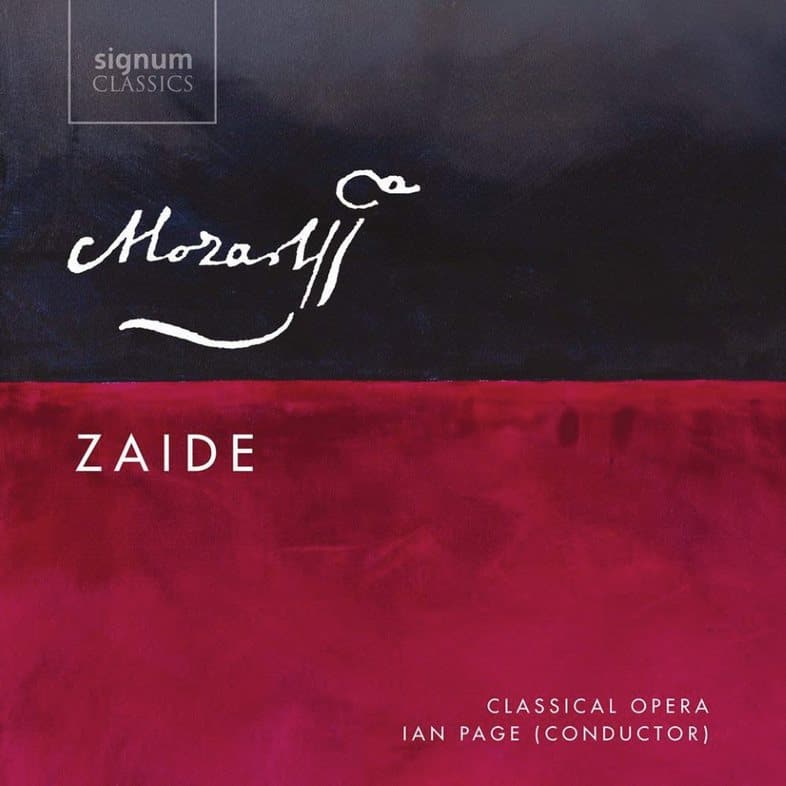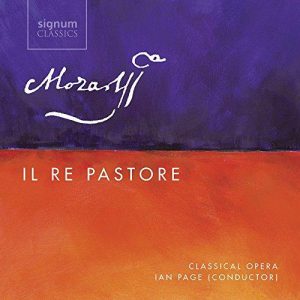Mozart: Zaide
£12.00
Continuing the company’s critically acclaimed complete cycle of Mozart operas on Signum Classics, Zaide was released on 16 September 2016. This was one of very few of Mozart’s works to be written without a commission, and Mozart completed fifteen numbers before abandoning the work to fulfil the commission for Idomeneo.
Continuing the company’s critically acclaimed complete cycle of Mozart operas on Signum Classics, Zaide was released on 16 September 2016. This was one of very few of Mozart’s works to be written without a commission, and Mozart completed fifteen numbers before abandoning the work to fulfil the commission for Idomeneo. These include two searing melodramas, some superb ensembles and a sequence of arias including the celebrated “Ruhe sanft”. The cast for this new recording comprises Sophie Bevan (soprano, Zaide), Allan Clayton (tenor, Gomatz), Stuart Jackson (tenor, Soliman), Jacques Imbrailo (baritone, Allazim), Darren Jeffery (bass-baritone, Osmin), and Jonathan McGovern (baritone, Vorsinger), with Ian Page conducting the Orchestra and Choir of Classical Opera.
To order your copy, please click the ‘Buy Now’ button or download a digital version from one of the sites below:
CD 1
- [Overture – Entr’acte from Thamos, König in Ägypten, K.345] 3:23
- No. 1, Coro: “Brüder, laßt uns lustig sein” (Vorsinger, Sklaven)1:01
- No. 2, Melologo: “Unerforschliche Fügung” (Gomatz)6:57
- No. 3, Aria: “Ruhe sanft, mein holdes Leben” (Zaide)6:04
- No. 4, Aria: “Rase, Schicksal, wüte immer” (Gomatz) 3:45
- No. 5, Duetto: “Meine Seele hüpft vor Freuden” (Zaide, Gomatz)2:10
- No. 6, Aria: “Herr und Freund, wie dank’ ich dir” (Gomatz)3:39
- No. 7, Aria: “Nur mutig, mein Herze, versuche dein Glück” (Allazim) 4:18
- No. 8, Terzetto: “O selige Wonne” (Zaide, Gomatz, Allazim) 5:59
CD 2
- No. 9a, Melologo: “Zaide entflohen” (Soliman) 4:24
- No. 9, Aria: “Der stolze Löw läßt sich zwar zähmen” (Soliman) 4:58
- No. 10, Aria: “Wer hungrig bei der Tafel sitzt” (Osmin)3:15
- No. 11, Aria: “Ich bin so bös’ als gut” (Soliman)5:47
- No. 12, Aria: “Trostlos schluchzet Philomele” (Zaide)6:49
- No. 13, Aria: “Tiger! wetze nur die Klauen” (Zaide)4:16
- No. 14, Aria: “Ihr Mächtigen seht ungerührt” (Allazim)4:31
- No. 15, Quartetto: “Freundin, stille deine Tränen” (Zaide, Gomatz, Soliman, Allazim)6:36
Slaves working on Sultan Soliman’s compound sing heartily as they return from another day of hard labour. As they disperse, one of their number, Gomatz, bemoans his fate and complains that he does not belong among such hardened criminals. He seeks solace in sleep.
While he sleeps, Zaide – the Sultan’s favourite slave in his harem – discovers him and tenderly watches over him, leaving her portrait by his side. When he awakens, Gomatz is overjoyed to find the portrait, and the two are soon united in love. With the help of the guard Allazim, who himself longs for a better life, they plot their escape together. As the three of them set out for freedom the sun rises and the sea is calm, although Zaide apprehensively imagines impending thunderstorms, and they pray for future happiness.
Act Two opens with the Sultan Soliman, who has been an ominous but invisible presence throughout Act One, raging at the news of the prisoners’ escape. He is assured that they will be swiftly recaptured, but he warns that once a proud lion has been crossed his nobility can quickly turn to tyranny. The overseer Osmin, who has presumably suggested that the Sultan comfort himself with another member of his harem, bemusedly scoffs at his master’s rejection of easy pleasure.
The prisoners are duly recaptured and brought before Soliman, who tells them that he rewards loyalty but punishes defiance; Zaide and Gomatz are to be executed. Zaide appeals for mercy, but when this is rejected she furiously turns on the Sultan and resolves to be united with Gomatz in death. Allazim also intercedes on their behalf, but Soliman remains steadfastly unyielding, insisting that Zaide and Gomatz must both die.
A literal tanslation of Mozart: Zaide into English can be read here.
Zaide – an introduction by Ian Page
Mozart never completed Zaide, although some seventy-five minutes of music have survived. In the autograph score, eleven of the fifteen numbers are prefaced by short cues that give the final few words of the preceding spoken dialogue. Aside from these, though, none of the spoken dialogue survives (we do know from Mozart, however, that there was a lot of it). The work is fascinating for a number of reasons – partly for the very nature of its incompleteness, partly because it dates from a particularly poignant and emotional time in Mozart’s short life, and partly because it is the longest of the very small number of works by Mozart which were not written in direct response to a commission or performance opportunity. At the point where Mozart broke off from composition, the story has seemingly developed as far as it possibly could from the expected happy ending, and we have no clear knowledge of the intended dénouement. The work did not even have a title until the first attempt was made, in 1866, to present it on stage.
Background
Mozart started work on Zaide in the autumn of 1779, when he was twenty-three years of age. Although he was not to know it, he was already more than halfway through his career. The contrast with his previous opera, Il re pastore, which had been premièred in Salzburg on 23 April 1775, could scarcely be greater, due in part to the aesthetic differences between German and Italian opera but more so to the developments in Mozart’s personal life during the intervening four-and-a-half years.
Mozart had been growing increasingly disenchanted and frustrated by the parochial limitations of musical life in Salzburg, but when – in the summer of 1777 – he petitioned his employer Archbishop Colloredo to release him from his position as a violinist in the court orchestra, the Archbishop petulantly responded by dismissing both Mozart and his father. Leopold Mozart sagely chose to demonstrate his professional loyalty and commitment by remaining in Salzburg, but on 23 September Wolfgang embarked on an extended tour to Munich, Mannheim and Paris, with his mother acting as chaperone. It was the first time he had ever been parted from his dominating father, and even by Mozart’s precocious standards the giddy array of fiercely intense emotions which he experienced during this sixteen-month trip represented a dizzying acceleration into adulthood.
The main purpose of the journey was to secure Mozart a composing appointment commensurate to his gifts (the court at Mannheim was first choice), but his approaches for employment were repeatedly met with rejection – firstly by the Bavarian Elector Max Joseph in Munich, then by a projected syndicate of private sponsors, also in Munich, next by the Elector Palatine Karl Theodor in Mannheim and finally in Paris, where, despite several opportunities to compose new works, Mozart suspected various malicious intrigues against him and was generally discontented; in Munich the dogged and well-intentioned efforts of the ailing composer Mysliveček to secure Mozart a major opera commission in Naples also came to nothing.
While in Mannheim Mozart befriended the family of Fridolin Weber, a singer, copyist and prompter at the opera house, and Weber’s three daughters all played a significant part in Mozart’s life. The eldest, Josepha, was subsequently to create the role of Queen of the Night in Die Zauberflöte and the youngest, Constanze, was a few years later to become Mozart’s wife, but it was the middle daughter, Aloysia, who made the most immediate impression on Mozart. He fell desperately in love with her, composing for her accomplished soprano voice and plotting her professional advancement; it was his besotted description of her in a letter home and his announcement of a planned educational and promotional tour to Italy with her which led Leopold Mozart to order Wolfgang and his mother to proceed to Paris without further delay.
The following summer, in mid-June, Mozart’s mother fell ill in Paris, and on 3 July she died. Wolfgang’s grief and sense of responsibility were as intense as they were natural, and only served to exacerbate what was already an unprecedentedly torrid period in his life. He remained in Paris, lodging with Friedrich Melchior Grimm (the family’s patron from their two previous visits to Paris), until his father wrote in September with news that, following the death of Anton Adlgasser, Archbishop Colloredo was offering Wolfgang the position of court and cathedral organist, with a substantial salary increase and generous allowance for leave. Mozart began his return journey, but any hopes that his pain might be alleviated by a reunion with Aloysia Weber were quickly thwarted; they met again in Munich, where Aloysia was now singing at the opera, but her reception of Mozart was heart-breakingly cool. Repeated professional rejection had thus been followed by bereavement and personal rejection which must have caused Wolfgang altogether deeper anguish. When he eventually returned home to Salzburg in the third week of January 1779, he had come full circle from the invincible young Wunderkind who had previously conquered Europe with a seemingly effortless musical facility and understanding.
Genesis
Salzburg has nowadays built a thriving tourist industry around its most famous son, but when Mozart returned there in early 1779 to resume his duties as a court musician he detested the place, describing it as a prison and his employment there as slavery. His fellow Salzburgers had given the strict and soulless Archbishop Colloredo the nickname ‘Grossultan’, and there was perhaps something therapeutically autobiographical about the choice of setting and subject matter for Zaide. “You are well aware, my dear friend,” Mozart had written from Paris on 7 August 1778 to the Abbé Bullinger, “how much I loathe Salzburg… I have far more hope of living a pleasurable and happy life in any other place… Salzburg is no place for my talent. In the first place, the court musicians there are not held in very high regard; and secondly, one hears nothing, there is no
theatre, no opera; and even if they really wanted to stage one, who would there be to sing?”
These assertions are not wholly accurate, for theatre was now available in Salzburg, even if it was not of a scale or level that Mozart would have wished for. In 1775 Colloredo had ordered that the Ballhaus on Hannibalplatz, previously owned by the Lodron family, should be converted into a public theatre, and visiting troupes gave regular performances there – predominantly plays but also musical theatre. Two of the most popular visiting companies were those led by Johann Heinrich Böhm (which presented Thamos, König in Ägypten and a German translation of Mozart’s La finta giardiniera) and Emanuel Schikaneder, Mozart’s future collaborator on Die Zauberflöte. Mozart composed and adapted music for both companies in return for free tickets to any of their performances.
Mozart might have had such troupes in the back of his mind when planning Zaide, but the main impetus for its composition was news that Emperor Joseph II was creating a new German opera company in Vienna. Leopold Mozart immediately wrote to his friend Franz von Heufeld, who advised that the Emperor already had Gluck and Salieri to write Italian operas for him but that the submission of a German opera by Wolfgang for the new company might open up opportunities for him in the Habsburg capital. Begrudgingly at first, for it was virtually unheard of for a composer of standing to compose an opera without any guarantee of performances or payment, Mozart set about choosing a subject with his chosen librettist, the long-standing family friend and Salzburg court trumpeter Johann Andreas Schachtner.
The libretto
The libretto of Zaide probably owed its genesis to two plays which had recently been performed in or near Salzburg. The secondary (though earlier) source was Voltaire’s Zaïre, a five-act tragedy which had first been performed on 13 August 1732 at the Comédie-Française in Paris. Written in verse in only three weeks, it had marked a significant departure from the ancient model in which the tragedy was prompted by a fatal flaw in the protagonist’s character, and it was conceived partly in reaction to criticism that Voltaire never placed love stories at the centre of his plays. Zaïre is a Christian slave who as a baby has been captured by Muslim armies invading Caesarea. Years later, while her fellow prisoner Nérestan has been allowed to return to France to raise a ransom, she has fallen in love with her master, the Sultan Osman, who has arranged to marry her. When Nérestan returns on her wedding day with the ransom money for all the Christian prisoners, she does not wish to be released, but an elderly slave called Lusignan joyfully recognises Zaïre and Nérestan as his long-lost children. Father and brother are horrified at the prospect of Zaïre becoming a Muslim, but the Sultan misinterprets their attempts to change her mind. Riddled with jealousy he stabs Zaïre to death, and when he realises the truth he kills himself with the same dagger.
Zaïre became one of Voltaire’s most popular and successful plays, and it was performed (in German) in Salzburg on 29 September 1777 with incidental music composed by Michael Haydn; Mozart was already in Munich by this date, but Schachtner may well have attended. Mozart made it very clear to his father that his interest at the time of Zaide was in writing serious opera, but no eighteenth-century opera, however bleak, would have shared Voltaire’s tragic ending.
The primary source for Zaide, then, was Das Serail, oder Die unvermuthete Zusammenkunft in der Sclaverey zwischen Vater, Tochter und Sohn (‘The Seraglio, or The unexpected Reunion of Father, Daughter and Son in Slavery’), written by Franz Josef Sebastiani with music by Joseph Freibert. It was performed in Wels (east of Salzburg) in 1777, in Erlangen in 1778 and in Bolzano in 1779, and Neal Zaslaw has suggested that Schachtner probably had the libretto on his desk as he wrote. Again, though, it seems unlikely that he and Mozart planned to replicate Sebastiani’s ending, in which Zaide and Gomatz (Comatz in the play) are spared by the Sultan when it is discovered that they are sister and brother, that Allazim (Renegat in the play) is their father, and that many years previously Renegat had saved the Sultan’s life. What survives of Zaide clearly sets Zaide and Gomatz up as romantic lovers, not relatives, and Mozart must surely have found Sebastiani’s ending abhorrently contrived.
The Mozart scholar Alfred Einstein’s discovery of a copy of the libretto for Das Serail from a 1779 revival of the work in Passau has enabled us to discover how extensively Mozart and Schachtner rewrote Sebastiani’s aria texts to provide Mozart with the metres and structures that he required, and it is safe to assume that their rewrites of the dialogue were even more sweeping. We will probably never know how they intended the story to end – they may never even have reached a decision themselves – but anything other than Zaide and Gomatz’s joyful and unimpeded union would have contradicted both operatic conventions of the time and Mozart’s own artistic temperament and beliefs as embodied in his other operas.
Abandonment
Mozart had composed the first fifteen numbers of Zaide, presumably representing the first two of a projected three acts, when he received the commission to write a new opera for Munich. He put the score to one side while he wrote Idomeneo, and the triumphant success of this work gave him the confidence to leave Archbishop Colloredo’s service and settle permanently in Vienna. He clearly continued to hold Zaide in high regard, and asked his father to send the manuscript on to him, but he subsequently wrote (on 18 April 1781): “As for Schachtner’s opera, there is nothing to be done – for the same reason which I have often mentioned before. Stephanie is going to give me a new libretto – a good one, he says – and if in the meantime I have left Vienna he will send [my manuscript] on to me. I could not contradict him. I merely said that, apart from the long dialogues (which can easily be shortened), the piece was extremely good, just not suitable for Vienna, where people prefer comedies”.
Stephanie’s “new libretto” was Die Entführung aus dem Serail, an opera which was altogether more comic and ‘vaudeville’ in style but which shared a similar subject matter. With no prospect of having Zaide performed, there presumably seemed little point in completing the work, and the manuscript was left to gather dust. Following his death it was discovered in Mozart’s library, but his widow was unable to identify it and sold it, among numerous other items, to the publisher and composer Johann Anton André. He gave the work its title (presumably considering with the benefit of hindsight that Sebastiani’s title of Das Serail would lead to confusion with Die Entführung), composed his own overture and finale to the work and commissioned new spoken dialogue. In this form the opera was finally given its première in Frankfurt on 27 January 1866, the 110th anniversary of Mozart’s birth. It was not very well received, however, and subsequent attempts to complete and stage the work have tended to prove similarly unsuccessful.
The music
The music which Mozart composed for Zaide consists of a short chorus, several arias, a duet, a trio, a quartet and two melodramas. Zaide’s three arias alone justify André’s decision to name the opera after its heroine. By far the best-known is the first, “Ruhe sanft”, with its hauntingly mellifluous harmonies and a searing melody whose yearning upward leaps already suggest the aspiration towards escape and fulfilment. Her two other arias, though, which unusually are placed back-to-back in the middle of Act Two, are no less remarkable, the first a beguiling appeal for mercy, the second a fierce launch into anger and accusation offset by a calm middle section in which she longs to be united with Gomatz in death. Gomatz’s two arias express firstly his joy and new-found strength on receiving Zaide’s portrait, and secondly his exuberant gratitude when Allazim offers to help them escape. In both cases the music masterfully captures and supports the dramatic situation. Allazim’s arias similarly reflect his philosophical but objective realism – the first perhaps the more distinctive melodically, but the second in its dramatic context a remarkably subtle evocation of understated defiance – while Soliman’s two arias are startlingly visceral and powerful expressions of his tyranny.
The ensembles are equally accomplished and dramatic, and in particular the quartet at the end of Act Two, in which the three victims’ soft and plaintive pleas for mercy are answered by the tyrant’s bullish assertions of unrepentance. As Robert Gutman memorably wrote: “In trio and quartet Mozart’s alchemy transmutes leaden words into gleaming gold; these are moments both human and transcendent, prodigies of his expanding genius”.
But perhaps the two most noteworthy and original numbers in the work are the two melodramas, in which spoken text is dramatically punctuated by free-flowing orchestral accompaniment. In Mannheim on his way back from Paris Mozart had heard the two acclaimed ‘duodramas’ by Georg Benda, Ariadne auf Naxos and Medea, both of which had been written as recently as 1775, and he was hugely excited by them, writing home to his father that “I like those two works of his so much that I carry them around with me… Do you know what I think? I think that most operatic recitatives should be treated in this way”. Despite his enthusiasm, though, Zaide is the only surviving work of his to employ melodrama (a setting of Semiramis which he is thought to have begun is lost), and the impact of the device is all the more powerful for being used sparingly.
Mozart always left the composition of the overture until he had completed the rest of the opera, and he therefore never got as far as writing one for Zaide. For this recording I have chosen an entr’acte from Mozart’s incidental music to Thamos, König in Ägypten, a darkly visceral movement which prepares the turbulent mood of the opera while at the same time paving the way for a potentially happy ending with its Beethovenian journey from minor to major.
© Ian Page
Zaide — Sophie Bevan (soprano)
Gomatz — Allan Clayton (tenor)
Allazim — Jacques Imbrailo (baritone)
Sultan Soliman — Stuart Jackson (tenor)
Osmin — Darren Jeffrey (bass-baritone)
Vorsinger — Jonathan McGovern (baritone)
Zaram — Darren Jeffrey
Sklaven — Peter Aisher, Robin Bailey, Simon Chalford Gilkes, Ed Hughes, Stuart Lang, Nick Morton, Dominic Walsh
The Mozartists, Bjarte Eike (leader)








